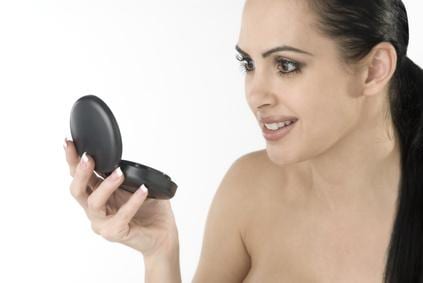It can be confusing when you walk down the makeup aisle. Suddenly, you face a dilemma–which type of makeup should you choose? The jury is still out as to which one is really the better of the two commonly used makeups–mineral or liquid. Many women prefer one to the other. Be the judge for yourself on which one is best for you by comparing the two.
Identification
Mineral makeups come in loose powder form in varying shades of brown for the foundation and different pigmented shades for the eyeshadows, blushes and lipsticks. They come in containers capped with small dispensing holes to control the amount to use. The applicators often come in the same packaging.
Some liquid makeups are more viscous than others. They come in varying shades that will match every color of skin and often use see-through capped bottles for packaging. Liquid eyeshadows, lipsticks and lipglosses use smaller packaging that varies from small tube-like bottles, round bottles and plastic tubes. Often, the packaging includes applicators or built-in dispensing caps.
Ingredients
Mineral makeups come from rocks and sediments that include mica, bismuth oxychloride, iron oxides, zinc oxide and titanium dioxide. They are devoid of harsh chemicals and preservatives.
Different liquid makeup companies have their own “secret” formula; however, they may contain harsh chemicals and preservatives. Some ingredients include isododecane, cyclopentasiloxane, isohexadecane, glycerin, disteardimonium hectorite, phenoxyethanol, magnesium sulfate, propylene carbonate and many more. Some liquid makeups contain parabens used as preservatives.
Application Method
Mineral makeups use only one type of applicator: a brush. Use small brushes for eyeshadows and lipsticks, medium or large for foundation and blushes. Apply mineral makeup using the swirl-tap-buff method. Dispense powder in the cap, swirl the brush on the powder, tap excess powder and buff brush on areas of your face where you need makeup.
A sponge is a common applicator for liquid makeups. Use a wedge sponge for applying foundation and use a small applicator tipped with a small sponge for eyeshadows. Use small flat brush for lipsticks, thin brush for eyeliners and small bristle brush for mascaras. Dip each applicator in a small portion of the type of liquid makeup you’ll use before applying.
Advantages
Mineral makeup feels light on your skin, as if you are not wearing any makeup. It is faster and easier to apply and remove than liquid makeup. The feel and look of mineral makeup is more natural than with liquid makeup. Mineral makeup is an ideal choice for people with sensitive skins due to lack of harsh chemicals.
If you like a longer-lasting makeup, liquid makeup may be your best bet. It sticks to your skin all day long, with only minor touch-ups needed. Liquid makeups have better coverage, especially if you have dark spots that you want to conceal.
Disadvantages
Mineral makeup does not last as long as liquid makeup; therefore, you may need several touch-ups throughout the day. It does not cover imperfections as well as liquid makeups do.
Liquid makeup runs or smears, especially when you tend to perspire a lot. It wears heavy and feels cakey. It can be difficult to remove. Washing your face thoroughly and using multiple cotton balls and facial cleansers are necessary to remove traces of liquid makeup.
Warning
In general, liquid makeups are safer than liquid makeups when it comes to the lack of harsh chemicals; however, by no means are they 100 percent safe. Recent studies show that titanium dioxide present in mineral makeups maybe carcinogenic. In addition, bismuth oxychloride, mica and zinc oxides may be harmful when repeatedly inhaled. On the other hand, aside from harsh chemicals, many liquid makeups use parabens as preservatives, which can be toxic and carcinogenic to humans.
Photo Credit
- woman doing her makeup image by Bruce Shippee from Fotolia.com





